‘Growing Fangs’ is a monthly article in which I write about the state of the Nashville Predators’ farm system and how individual prospects are performing. I wrote the first installment in November when I introduced some of the team’s most-touted prospects. Starting with this month, and continuing in subsequent months, the articles will recap player performances from that month.
Related: Last Month’s Growing Fangs
I’m changing up my ‘Growing Fangs’ series for January and the months that follow. Instead of writing about prospects in a trending up and down manner, I’m ranking the top-10 Predators prospects and discussing their performances in January. My reasoning for altering the series is to ensure that I generally cover the same prospects each month, making their performances easier to track. Of course if a prospect has a standout month, good or bad, I will move him in or out of the top-10. With that being said, here are my 10 best Predators prospects from January.
My Top-10 for January
1. F Eeli Tolvanen, Milwaukee Admirals
- Draft Information: 2017 1st Round (30th Overall)
- Season Stats: 29 games played (GP), 7 goals (G), 8 assists (A), 1 power-play goal (PPG), 5 power-play assists (PPA)
- January Stats: 5 GP, 3 G, 0 A
Finnish winger Eeli Tolvanen is the Predators’ clear-cut top prospect. He was talented enough to play in the NHL after his KHL season ended in 2017-18 and would likely be on most club’s NHL rosters. In fact, if it weren’t for the Predators’ forward depth, he would probably currently be in the NHL.
He hasn’t produced the way most would like, but has been heating up lately, including a two-goal performance against the Manitoba Moose on Jan. 26. Some fans may be frustrated with how long it’s taking him to develop, but the Predators have been smart in their patience with him. He still possesses the skills that will make him a dynamic scoring threat, including smooth hands, an elite shot and the ability to find soft spots in coverage as shown in the goal below against the Moose.
TIC-TAC-TOLVANEN!! 🙌 pic.twitter.com/P5n4fYxrSv
— Milwaukee Admirals (@mkeadmirals) January 26, 2019
But his game has become more than scoring goals. He’s developing into a better passer and has worked on his defensive game. When he represented Finland at the 2019 World Junior Championships, his inability to finding the back of the net could have frustrated him. However, his four assists still helped his nation capture gold, and he played a pivotal role on the game-tying goal against Canada before the Finns won in overtime. Although it’s taking awhile for him to be a steady contributor in the NHL, his ceiling remains sky-high.
2. D Dante Fabbro, Boston University
- Draft Information: 2016 1st Round (17th Overall)
- Season Stats: 23 GP, 5 G, 16 A
- January Stats: 7 GP, 2 G, 6 A
If there is a prospect who could threaten Tolvanen for the top spot, it’s defenseman Dante Fabbro. He is the Predators’ top defense prospect, is in his junior season at Boston University and serves as the squad’s captain. His 21 points leads the Terriers and tie for 13th among NCAA defensemen.
On a B.U. team that lost a lot of talent from last season, Fabbro has stood out. On Jan. 11 against the University of New Hampshire, he netted a goal and two assists. Like Tolvanen, Fabbro is talented enough to step into an NHL lineup and at least play on a bottom pair, which leads us to an interesting conversation.
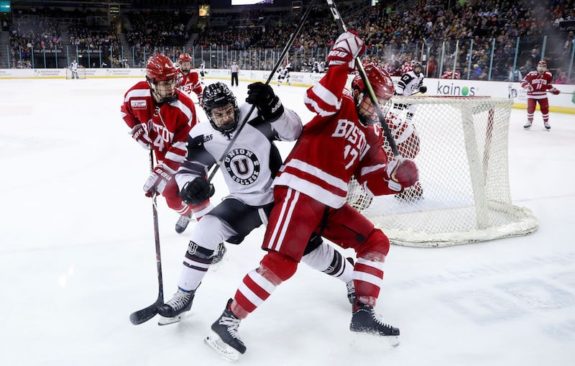
If he wants to, he can sign his entry-level contract (ELC) and join the Predators this spring. I think Predators GM David Poile will push for Fabbro to sign this spring and join the NHL club for its stretch run and in the playoffs. The Predators may already have one of the league’s best blue lines, but there’s still room for Fabbro. As a 6-foot-1, right-shot defenseman, he has the size NHL teams look for. He’s a great two-way blueliner who can quarterback a power play without being a liability. There’s a spot for him, now we just wait with bated breath to see what he does.
3. F Emil Pettersson, Milwaukee Admirals
- Draft Information: 2013 6th Round (155th Overall)
- Season Stats: 46 GP, 11 G, 21 A, 1 PPG, 1 shorthanded goal (SHG), 9 PPA, 3 game-winning goals (GWG)
- January Stats: 12 GP, 4 G, 8 A
At 25 years old, Emil Pettersson is at the upper-end of what is considered a prospect, but his trajectory continues to trend upward, especially when you take into account that this is only his second season in North America. Pettersson, the older brother of Vancouver Canucks star Elias, led the Admirals in scoring last season with 46 points in 72 games. He recently took over the team-lead in scoring this season and his point-per-game average is higher in 2018-19 than it was in 2017-18.
What’s interesting about Pettersson is that, apart from his final season in Sweden’s SHL, he’s had higher scoring rates in the AHL than he did before leaving Sweden. And while he doesn’t have the pedigree of other prospects on this list, he should be the first player the Predators turn to when they recall someone, especially when looking for a trustworthy player.
He has developed into a consistent producer who knows what to do in every zone. In the Admirals’ Jan. 22 game against the Moose, Pettersson got in on the scoring in the 8-2 victory with two goals and one assist. He may not have the ceiling of other prospects, but he is the kind of player who can have a long career in the NHL.
4. D Frédéric Allard, Milwaukee Admirals
- Draft Information: 2016 3rd Round (78th Overall)
- Season Stats: 43 GP, 3 G, 20 A, 1 PPG, 6 PPA
- January Stats: 9 GP, 0 G, 5 A
Defenseman Frédéric Allard has done nothing but skyrocket up the Predators prospect ranks due to his accelerated development. The Predators drafted him after three solid, but not standout seasons in the QMJHL. He played in 55 games with eight goals and 24 points with the Admirals in 2017-18 in his first professional season.
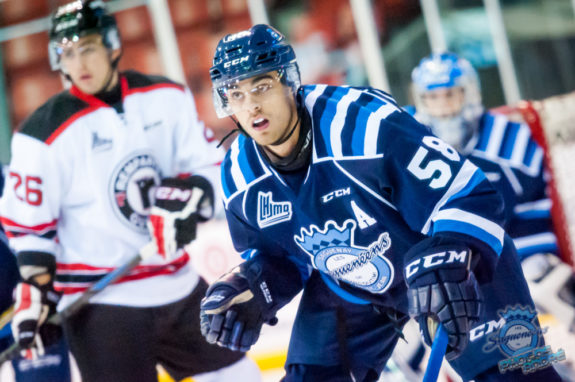
Allard is simply a really good defenseman. He’s not elite at anything, but he’s also not bad at anything. He provides offense from the blue line, is confident and safe with the puck, can be trusted in one-on-one situations and uses his stick well to defend. As another right shot blueliner, he already has an advantage, but when you factor in his 6-foot-1, 179-pound frame, he looks like an NHL defenseman.
He may have been taken one round after former Predator Samuel Girard, but Allard may have the higher upside. He has also surpassed current Predators prospect Alexandre Carrier on the prospect ranks, which has more to do with Allard’s play than Carrier’s struggles. Considering Allard, Carrier and Fabbro are all right-shot defensemen, it’s not a stretch to think the Predators have their future right-shot defensemen figured out.
5. D Alexandre Carrier, Milwaukee Admirals
- Draft Information: 2015 4th Round (115th Overall)
- Season Stats: 46 GP, 2 G, 17 A, 1 PPG, 6 PPA, 2 shorthanded assists (SHA)
- January Stats: 12 GP, 0 G, 8 A
As referred to above, Carrier getting passed by Allard has nothing to do with a regression in Carrier’s development. The right-shot blueliner may be slightly smaller at 5-foot-11 and 174 pounds, but he still has a path to the NHL. It’s difficult to project the NHL arrival times for defensemen because they generally take longer to develop than forwards. However, he possesses the appropriate tools to fit into the Predators’ blue line.
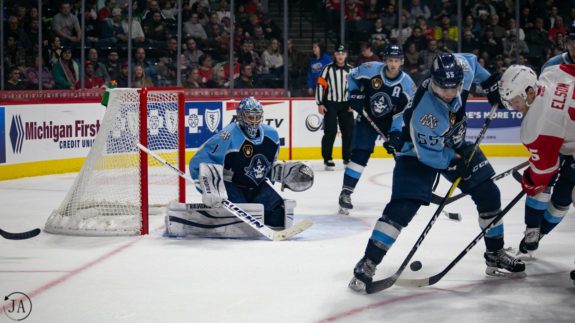
Like Allard and Fabbro, Carrier is confident with the puck and has the vision to make difficult passes, as evident by his eight assists in January, and a dynamic shot that can take advantage of questionable defenses. Ahead of the 2015 Draft, EliteProspects’ draft profile for Carrier stated “All-in-all, an all-around defenseman that excels in reading plays and creating chances.” He’s the type of defenseman teams love: solid in his own zone, unafraid to lead a rush, but is quiet and steady in doing so.
6. F Anthony Richard, Milwaukee Admirals
- Season Stats: 43 GP, 17 G, 14 A, 4 PPG, 5 PPA, 2 GWG
- January Stats: 12 GP, 5 G, 5 A
Anthony Richard earned a cup of coffee in the NHL earlier this season due to the injuries that piled up for the Predators. He led the Admirals in scoring for much of the season before recently being surpassed by Pettersson. Despite Richard’s diminutive 5-foot-10, 163-pound frame, he has produced at every level.
#Preds recall Anthony Richard from the @mkeadmirals. In addition, Filip Forsberg has been placed on Injured Reserve and will miss 4-6 weeks with an upper-body injury. Nick Bonino will miss tonight's game due to illness and is day-to-day. https://t.co/xK0XVyImqo
— Nashville Predators (@PredsNHL) December 2, 2018
He was better than a point-per-game player his final two seasons in the QMJHL while his scoring rate has increased each of his three AHL seasons to its current .72 points-per game. And although Pettersson may have a higher point total, Richard has the higher average. He has been on a tear since being returned to the AHL, including a four-point effort, with three goals and an assist, against the San Antonio Rampage on Jan. 22.
Given that he’s shooting 17.5 percent this season, it’s evident that he has an accurate shot that is able to beat goalies. It’s also a skillset that translates to the NHL despite him being shorter than six feet tall. If Richard develops into a consistent NHLer, it will almost assuredly be in a bottom-six role as his ceiling is limited.
7. F Patrick Harper, Boston University
- Draft Information: 2016 5th Round (138th Overall)
- Season Stats: 23 GP, 2 G, 11 A, 1 GWG
- January Stats: 7 GP, 1 G, 5 A
Patrick Harper is perhaps the most interesting prospect on this list. If everything breaks right for him, he could have a future as a top-six forward in the NHL. However, there’s also the chance he never reaches the NHL. He fell to the Predators in the fifth round despite a strong high school career. The main reason for him falling is his 5-foot-9, 160-pound frame.
However, Johnny Gaudreau and the Predators’ own Viktor Arvidsson are also small, yet successful players, and Rocco Grimaldi, also a Predator, has carved out a role for himself this season despite being the shortest player in the league at 5-foot-6. Harper, despite being small, has produced at every level, including his first two seasons at Boston University with 58 points in 58 games entering this season, although his 2017-18 season ended prematurely with a mysterious illness.
Related: Top 10 Undersized NHL Players
He followed up that situation with a slow start to 2018-19 with one goal and six assists in his first 16 games. Was that start due to lingering effects from his illness? Possibly, but it’s uncertain. All we know is that he has been heating up recently with one goal and five assists in seven games in January, including a one-goal, two-assist effort versus Merrimack College on Jan. 21. Harper may be undersized, but he has excellent vision, knows what to do with the puck on his stick and creates space for himself to unleash an above average wrist shot.
8. F Rem Pitlick, University of Minnesota
- Draft Information: 2016 3rd Round (76th Overall)
- Season Stats: 25 GP, 15 G, 13 A, 6 PPG, 2 SHG, 1 GWG
- January Stats: 8 GP, 7 G, 4 A
When Rem Pitlick led the University of Minnesota in points last season with 31 points in 38 games, most chalked it up to him playing on Casey Mittelstadt’s line. However, fast-forward to this season and Pitlick is again leading the Golden Gophers in points with 28 in 25 games and Mittelstadt is in the NHL. In his third season of college hockey, Pitlick is averaging better than a point-per-game for the first time.
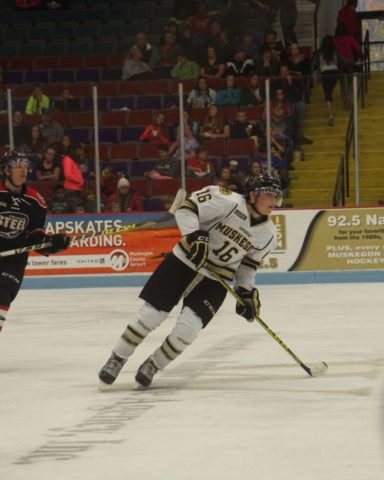
Although he went a little under the radar in his draft and has continued to do so since, Pitlick continues to prove he has the potential to develop into a consistent producer. He has succeeded at every level, including playing at prestigious Shattuck St. Mary’s and following it up two seasons later with a dominant season in the USHL.
This season, Pitlick is carrying Minnesota with a one-point and five-goal lead on teammates. His footspeed is a plus tool as are his vision and shot and the fact that he is left-handed would breathe some fresh air into Nashville’s righty-dominated forward group. If he is to become a regular in the NHL, he will need at least one full AHL season to get used to the professional game. Because he is a junior like Fabbro, look to see if Pitlick signs his ELC after this season ends.
9. F Yakov Trenin, Milwaukee Admirals
- Draft Information: 2015 2nd Round (55th Overall)
- Season Stats: 46 GP, 7 G, 12 A, 1 PPG, 3 PPA, 1 GWG
- January Stats: 12 GP, 4 G, 6 A
At 6-foot-2 and 211 pounds, Russian Yakov Trenin already has an NHL-ready frame. In his second professional season, he has surpassed his scoring totals from 2017-18, although he only played in 44 games last season. Like several others on this list, he has been heating up recently and had more goals in his past 12 games than he did in his first 34. He also put in a two-goal, two-assist performance against the Rampage on Jan. 22.
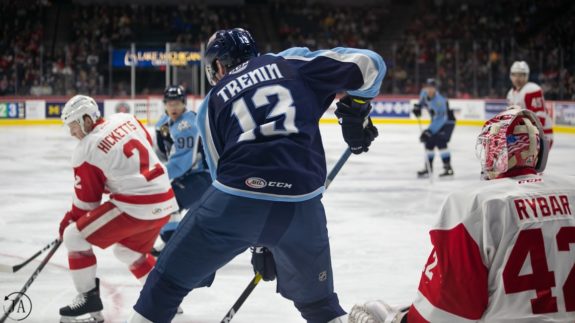
What’s interesting about Trenin is that he bucks the stereotype that Russian forwards are only committed to scoring goals. He can do that, and was better than a point-per-game player in all three of his QMJHL seasons, but then again, so are a lot of prospects without much potential. What sets him apart is that he is already pretty good at playing a strong two-way game. While the plus/minus stat is fairly archaic, his plus-12 on the season does show he either gives his team a boost when he’s deployed or is extremely fortunate.
What is unknown is whether or not he can produce enough offensively to reach the NHL, which even if he does, he’ll likely serve a bottom-six role. If he can continue his recent stretch of strong play and find his scoring touch, it will combine with a big frame that is difficult to move off the puck to create a useful two-way center.
10. D David Farrance, Boston University
- Draft Information: 2017 3rd Round (92nd Overall)
- Season Stats: 23 GP, 4 G, 10 A, 2 PPG, 1 GWG
- January Stats: 7 GP, 3 G, 2 A
Breaking the run of right-shot defensemen is David Farrance, currently a sophomore at Boston University. He is the wild card on this list. Had I compiled this list in December, he may not be on the list, but his production in January, including a two-goal performance against Merrimack on Jan. 21, made his case. What makes him a wild card is not knowing who he currently is, or what he can become.
He arrived at B.U. with a lot of notoriety having played for the U.S. National Development Program and represented the United States at the 2017 U-18 Tournament. But in 2017-18, his freshman season, the Terriers had a full blue line, which forced him to play on the wing at times and he was not productive. However, this season he is back on defense and has partnered with Fabbro and has played much better. His greatest assets are his vision and hands, which allowed him to transition to forward, and his ability to carry the puck end-to-end resembles Roman Josi’s own ability.
While he hasn’t gotten exposed at the collegiate level like some thought he might, there are still concerns about how his game transitions to the professional levels, especially defensively. Yet despite this, it’s hard not to dream of a future with he, Allard, Carrier and Fabbro replacing Nashville’s current top-four. However, if that doesn’t work, there is always the possibility of Farrance switching long-term to the wing.
Outside Top-10, But Knocking on the Door
F Grant Mismash, University of North Dakota
- Draft Information: 2017 2nd Round (61st Overall)
- Season Stats: 21 GP, 5 G, 4 A, 2 PPG, 1 GWG
- January Stats: 4 GP, 0 G, 0 A
Grant Mismash is a talented forward whose skills haven’t translated to on-ice success this season for the University of North Dakota. His nine points in 21 games are a long way off from the 22 points in 38 games he had last season as a freshman. Part of his regression could be linked to North Dakota not having as talented of a roster this season. Either way, he hasn’t picked up where last season ended. There’s also the likelihood that his season is over due to a knee injury he suffered against St. Cloud State on Jan. 26 that dampens his status.
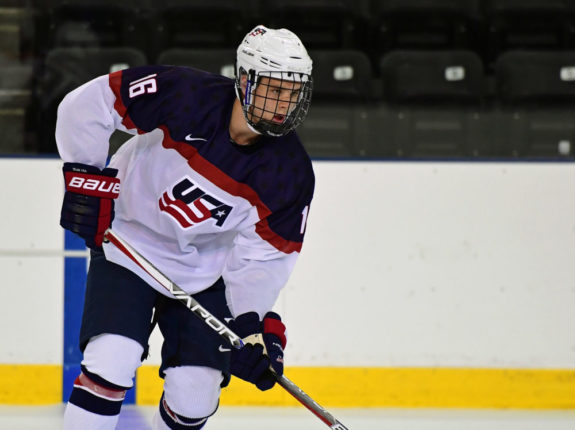
But still, even without the production you’d like to see from him, he remains a talented hockey player with a possible NHL future. His hockey IQ is off the charts and he consistently provides support for teammates in all zones. He also knows how to create space for himself, protects the puck well and doesn’t need much room to get his shot off. Even if his season is over, Mismash remains a talented prospect and will be one to pay attention to next season as a junior.
F Jáchym Kondelík, University of Connecticut
- Draft Information: 2018 4th Round (111th Overall)
- Season Stats: 24 GP, 3 G, 19 A, 1 GWG
- January Stats: 6 GP, 2 G, 5 A
A true project of a prospect, Jáchym Kondelík is thriving as a freshman with the University of Connecticut. His 22 points on the season not only lead the Huskies but are tied for third in the nation among freshmen. Plus he’s doing this with little help around him as UConn is not very good. At 6-foot-7, 218 pounds, he has the frame to succeed in the NHL, if he can skate well enough.
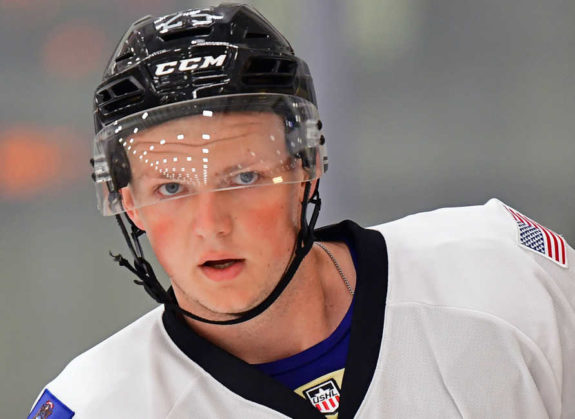
He improved in this department in his draft season, but will need to continue doing so to eventually transition to the professional levels. With his size, he has the reach that allows him to get to pucks and defend in ways that shorter players can’t. If he develops in an ideal manner, he will become a net-front nightmare for opposing goaltenders and defensemen as he would be bigger than most players on the ice. Ahead of the 2018 Draft, THW’s Mark Scheig had this to say about Kondelík:
“Basically, he’s got an element of everything in his game. Where questions come in with Kondelik is how his game translates at the next level. With the game transitioning to a faster game, can he keep up the pace? And while he can do a little of everything, including playing top line minutes, there isn’t one defined skill that is high end. Can he use the summer to take parts of his game to a new level, especially his offensive output?” The Hockey Writers’ draft profile for Kondelík
While it’s unlikely he improves every skill to above average, he has clearly devoted himself to improving his offensive game. His point-per-game rate has increased each of the past three seasons and is currently at a career high. If he can improve at least one other tool as much as his skating, he has a future in the NHL. If he continues scoring at this rate and his trajectory continues to climb, he’ll be in the top-10 sooner than later.
Let me know in the comments below what your thoughts are on the Predators’ farm system, individual prospects and how I ranked them.
*All stats from EliteProspects, the American Hockey League and individual team sites